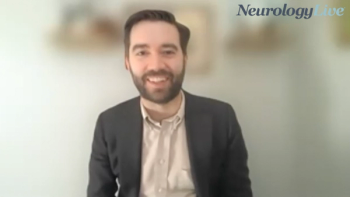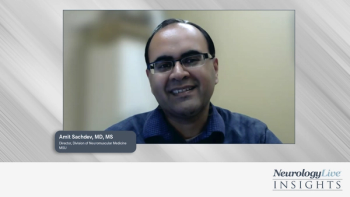
NeuroVoices: Barry Hendin, MD, on World MS Day and Trends in MS Care
The neurologist from Banner Health and chief medical officer of the MS Association of America discussed the significance of World MS Day and how clinical care of MS has evolved.
On May 30, the global multiple sclerosis (MS) community will come together to recognize World MS Day, giving those affected by MS, along with caretakers and the clinical team, an opportunity to raise awareness of the disease by sharing their experiences. Today, 2.3 million people around the world have MS, most of whom are diagnosed between the ages of 20 and 40. Notably, women are 2 to 3 times more likely to develop MS than men.
While much progress has been made in efforts to modify the course of the disease, research continues to someday identify a curative treatment. With more than a dozen disease-modifying treatments now available, people with MS and their clinicians have more control than ever to create an individualized treatment plan that prioritizes patient preferences and addresses the multitude of symptoms associated with the disease, including numbness, tingling, vision problems, balance and mobility issues and cognitive effects such as the inability to concentrate, impaired problem-solving skills, and trouble with spatial relations.
To learn more about this global effort to shine a spotlight on MS and gain a better understanding of current research and treatment trends, NeurologyLive spoke with Barry Hendin, MD, a neurologist at Banner Health and chief medical officer of the MS Association of America.
NeurologyLive: What is the significance of World MS Day?
Barry Hendin, MD: Anytime you have an opportunity to increase awareness about MS, it’s a good thing. World MS Day is a world awareness event, not just for people in the US or North America, but for people across the globe to be connected. We’re not part of a small community, we’re part of a worldwide community. If you look at the participants, it’s not just the National MS Society, but it’s societies around the globe. It tells us that this isn’t a problem located in a place, but that it expands worldwide. It’s the connectivity that I think is the important level of awareness. For me, that is the big deal. There are a lot of organizations that contribute to awareness in the US—3 in particular. They are the MS Association of America, the Consortium of Multiple Sclerosis Centers, and the National Multiple Sclerosis Society. In saying that, it seems that all of us believe that the more we can heighten awareness, the more we can connect to our local institutions and local providers. It’s more about the value of voices, and more connectivity.
Since you began practicing, how has the state of MS care changed?
I’ve been a neurologist for a long time, and when I came into neurology, there were no disease-modifying therapies whatsoever. If you had MS, we could educate and diagnose, but we couldn’t change the trajectory of MS until 1993. At that point, we had 1 medication and in the early 1990s we increased that to a few medications, which were for relapsing forms of MS. The gratifying part of being able to maintain an MS practice is watching how it has evolved and how much more is offered to clinicians treating MS and people with MS.
Some people say, ‘what in MS interests you?’ My routine answer, besides the explosion of knowledge, is the ability to change the trajectory of life. If you said, ‘Are we getting better at treating forms of MS? Have we gone from a few medications to more than 20 medications?’ Absolutely. In regard to progress, we think we’re best at treating the inflammatory part of MS. We haven’t been as successful in treating progression of MS, but that’s one of the reasons that a lot of attention has been placed on active, progressive MS.
Mayzent (siponimod) has been a large part of that. It’s not about the medication, but rather that the trials that involved Mayzent were more important for getting rid of the nihilism about progressive MS. Up to that point in time, there had been a great deal of nihilism based on some of the French literature stating that once you reached a certain level of disability, there wasn’t much you could do. The Mayzent trials were important for me, as a clinician, in showing that a patient with a more severe MS still could have its trajectory changed. For me, it was a way of successfully challenging nihilism. The belief now based on a lot of data is that when there’s active, secondary progressive MS, there’s more we should do and can do.
What treatment trends are you watching most closely currently?
There’s always been a discussion in MS as to whether late progression represented the failure of sufficient therapy early on, or whether progression was inevitable, independent of successful early treatment. The literature tells us that the primary engine driving late progression is the failure to treat effectively early on. For me, the first thing that is important is this concept that early treatment with effective agents is our best shot at reducing late disability. That’s a principle that doesn’t go away for me at all. The second part is that most of the agents we’re using for relapsing MS are approved for active secondary progressive MS. The question is, is there something we can do that is reparative or restorative for later MS, not active? I have participated in trials and am keeping my eye on trials of reparative strategies, which are still a ways away from fruition.
Given your emphasis on early, effective treatment, what are your thoughts on the ongoing debate between induction versus escalation therapy?
It’s an important concept. I don’t think that debate has ended. In academic centers, there’s a greater tendency to start higher efficacy agents early. In the community, there’s a greater tendency to start with simpler agents, and then escalate late. In some ways, it also may be a false binary. If you ask people what they’re actually doing, they may not want to place themselves in either category of escalators or early use of high efficacy treaters, but rather say that they treat the individual patient in front of them and then if it looks like a good prognosis patient, they’ll start with something lower. If it looks like a poor prognosis patient, they’ll start with something higher.
One of the reasons that I have philosophically been in favor of starting higher-efficacy agents early is that, although for populations we have prognostic data, for the individual in front of us, our ability to predict that individual’s course when we see them the first time around is not very good. We may think we know who is a good versus poor prognosis patient, [but] we don’t. Therefore, it is a safety effort to use the higher-efficacy agents early in that regard.
I overtreat the few to protect the many. I recognize that some people would have done well, even on low-efficacy agents. I just don’t know who they are. Although I use all the agents, my philosophy and tendency is to prefer the high-efficacy agents. In the past, as you moved up from lower-efficacy agents to higher-efficacy agents, you dealt with more immunosuppressive risks. We’ve reached a time where we can move to higher-efficacy agents without incurring additional immunosuppressive hazard. I can move up from less agents to better agents without significant increase in risk, and all of those things compel me toward the earlier use of high-efficacy agents.
When prescribing therapies, how much hinges on the patient’s needs compared to the prognosis of their disease?
Within the 3 categories of low-, middle-, and high-efficacy, there are choices as traits as a vehicle. There are 3 people trying to make that decision. They are the clinician, the patient, and the payer. It’s important that the patient have a voice and saying when they can or can’t tolerate a drug. In terms of side effect profile, also telling what you can and can’t tolerate, as well as the risk associated. It has to be collaborative, not only to empower the patient voice, but because if it doesn’t work, things tend not to go well. If the person in front of you doesn’t agree with your choice, it won’t happen or it won’t persist.
Transcript edited for clarity.
Newsletter
Keep your finger on the pulse of neurology—subscribe to NeurologyLive for expert interviews, new data, and breakthrough treatment updates.



































